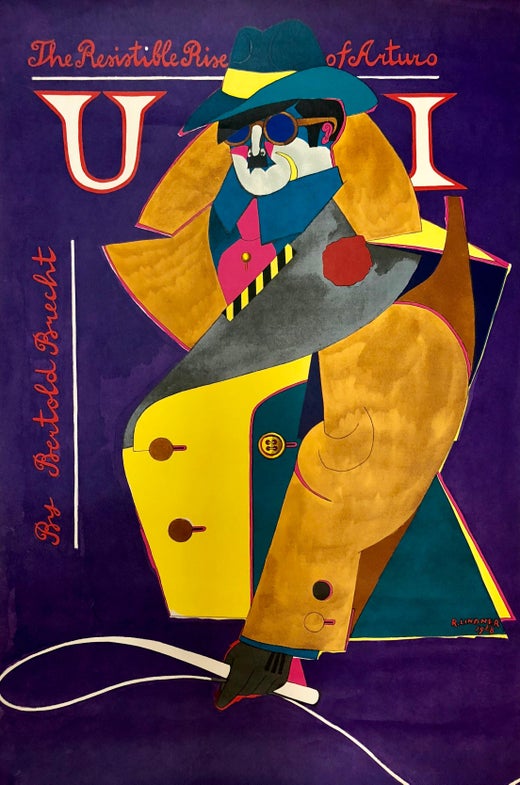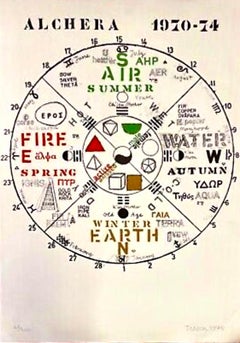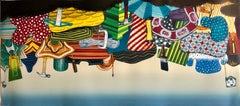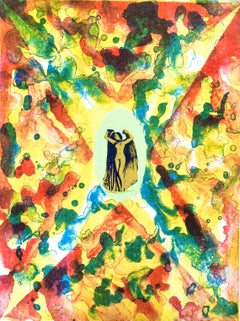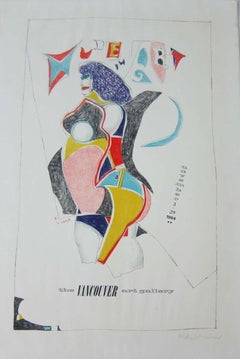Want more images or videos?
Request additional images or videos from the seller
1 of 10
Richard LindnerVintage Modern Lithograph Poster 1960s Pop Art Mod Figure Pencil Signed1964
1964
$1,200List Price
About the Item
- Creator:Richard Lindner (1901-1978, American)
- Creation Year:1964
- Dimensions:Height: 29 in (73.66 cm)Width: 20 in (50.8 cm)
- Medium:
- Movement & Style:
- Period:
- Condition:
- Gallery Location:Surfside, FL
- Reference Number:1stDibs: LU382116534
Richard Lindner
Richard Lindner (1901 – 1978) was a German-American painter. Lindner's mother was owner of a custom-fitting corset business and Richard Lindner grew up and studied at the Kunstgewerbeschule (Arts and Crafts School since 1940 Academy of Fine Arts). From 1924 to 1927 he lived in Munich and studied there from 1925 at the Kunstakademie. In 1927 Lindner moved to Berlin and stayed there until 1928, when he returned to Munich to become art director of a publishing firm. He remained in Munich until 1933, when he was forced to flee to Paris. Once in Paris, Lindner became politically engaged, sought contact with French artists and earned his living as a commercial artist. He was interned when World War II broke out in 1939 and later served in the French Army. In 1941, Lindner moved to the United States and worked in New York City as an illustrator of books and magazines. There he made contact with New York artists and German emigrants such as Albert Einstein, Marlene Dietrich, and Saul Steinberg. In 1948, Lindner became an American citizen. Lindner taught at a number of institutions including the Pratt Institute, Brooklyn, Hochschule fur bildende Kunste in Hamburg and Yale University School of Art and Architecture. His paintings often used the sexual symbolism of advertising and investigated definitions of gender roles in the media.
About the Seller
4.9
Platinum Seller
Premium sellers with a 4.7+ rating and 24-hour response times
Established in 1995
1stDibs seller since 2014
1,837 sales on 1stDibs
Typical response time: 1 hour
Authenticity Guarantee
In the unlikely event there’s an issue with an item’s authenticity, contact us within 1 year for a full refund. DetailsMoney-Back Guarantee
If your item is not as described, is damaged in transit, or does not arrive, contact us within 7 days for a full refund. Details24-Hour Cancellation
You have a 24-hour grace period in which to reconsider your purchase, with no questions asked.Vetted Professional Sellers
Our world-class sellers must adhere to strict standards for service and quality, maintaining the integrity of our listings.Price-Match Guarantee
If you find that a seller listed the same item for a lower price elsewhere, we’ll match it.Trusted Global Delivery
Our best-in-class carrier network provides specialized shipping options worldwide, including custom delivery.You May Also Like
Leo Castelli Gallery (Landscape with Red Sky) Poster /// Roy Lichtenstein Pop
By Roy Lichtenstein
Located in Saint Augustine, FL
Artist: (after) Roy Lichtenstein (American, 1923-1997)
Title: "Leo Castelli Gallery (Landscape with Red Sky)"
Year: 1985
Medium: Original Offset-Lithograph, Exhibition Poster on smoo...
Category
1980s Pop Art Abstract Prints
Materials
Lithograph, Offset
$900
H 38.5 in W 23.5 in
Modern Print /// Roy Lichtenstein Pop Art Abstract Geometric MoMA Gemini G.E.L.
By Roy Lichtenstein
Located in Saint Augustine, FL
Artist: Roy Lichtenstein (American, 1923-1997)
Title: "Modern Print"
*Numbered, signed, and dated by Lichtenstein in pencil lower right
Year: 1971
Medium: Original Lithograph and Scr...
Category
1970s Pop Art Abstract Prints
Materials
Lithograph, Screen
“The Winter Ball” 1988
Located in Austin, TX
Poster Size: 23.5 x 16.5 in.
Vintage Gold Leaf Frame Size: 23.5 x 16.5 in.
Signed and inscribed in gold marker, bottom right
A poster for "The Winter Ball 1988" in Houston, Texas, p...
Category
1980s Pop Art Animal Prints
Materials
Paper, Lithograph, Offset
The King
By Keith Haring
Located in Hollywood, FL
Artist: Keith Haring
Title: The King
Size: 23 3/8 × 29 7/8 in 59.4 × 75.9 cm
Medium: Lithograph
Edition: of 50
Year: 1989
Notes: Hand Signed, Numbered & Dated in Pencil. Custom F...
Category
1980s Pop Art Abstract Prints
Materials
Lithograph
Derriere l'etoile
By James Rosenquist
Located in Hollywood, FL
Artist: James Rosenquist
Title: Derriere l'etoile, 1977
Medium: Color Lithograph on Arches Cover Paper
Size: 36 1/2 x 74 inches
Edition: 74 of 100
Year: 1977
Notes: Hand Signed, Num...
Category
1970s Pop Art Abstract Prints
Materials
Lithograph
Original Hawaii American Airlines Psychedelic Flower Power vintage poster
Located in Spokane, WA
Original American Airlines Hawaii Vintage Poster - Authentic 1960s Travel Memorabilia. Archival linen backed in very good condition, A-. N...
Category
1960s Pop Art Abstract Prints
Materials
Lithograph
$1,395
H 40 in W 30 in D 0.05 in
As I Opened Fire Poster, Triptych
By (after) Roy Lichtenstein
Located in New York, NY
Set of 3 color offset lithographs. The last panel is signed in pencil. Printed by Drukkerij Luii & Co., Amsterdam. Published by the Stedelijk Museum, Amsterdam. This is a reproductio...
Category
1960s Pop Art Abstract Prints
Materials
Color, Lithograph, Offset
Polish Rider
By Larry Rivers
Located in New York, NY
A very good impression of this color lithograph on Arches. Signed, dated and numbered 49/90 in pencil by Rivers. Printed by Styria Studio, Inc., New York, with the blind stamp lower left. Based on Rembrandt van Rijn's oil on canvas, "The Polish Rider," 1655, currently in the Frick Collection...
Category
1980s Pop Art Abstract Prints
Materials
Color, Lithograph
Fun City, N.Y.C.
By Richard Lindner
Located in New York, NY
A very good impression of this color lithograph. Signed and numbered 125/175 in pencil, lower margin.
Category
1970s Pop Art Abstract Prints
Materials
Color, Lithograph
Expo 67 Mural--Firepole 33' x 17'
By James Rosenquist
Located in New York, NY
A very good impression of this color lithograph on Italia handmade paper. Signed, titled, dated and numbered 35/41 in pencil by Rosenquist. Printed and published by ULAE, West Islip,...
Category
1960s Pop Art Abstract Prints
Materials
Handmade Paper, Color, Lithograph
More From This Seller
View AllJoe Tilson British Pop Art Screenprint, Color Lithograph 4 Seasons 4 Elements
By Joe Tilson
Located in Surfside, FL
Silkscreen screenprint or Lithograph
Hand signed and numbered. An esoteric, mystical, Kabbala inspired print with Hebrew as well as other languages.
Joseph Charles Tilson RA (born 2...
Category
1970s Pop Art Abstract Prints
Materials
Screen, Lithograph
Color Lithograph Linocut Chine Collé "Workshop" Bright Modernist Pop Art
By Tom Burckhardt
Located in Surfside, FL
Hand signed and numbered edition of 25. 16 x 36" sheet size without frame.
“Workshop” is an ambitious color lithograph and linocut with chine collé printed in twelve colors from nine plates and one linocut. It has been printed in an edition of 25, plus proofs, on white Rives BFK paper 16 x 36” with chine collé of various papers. (No, it’s not upside down)
Born 1964 in New York where he still currently resides and works alongside his partner the ceramist Kathy Butterly. Son of the photographer Rudy Burckhardt and painter Yvonne Jacquette, Tom Burckhardt was 1986, BFA, State University of New York, Purchase, NY
1992–1993, Skowhegan School of Painting and Sculpture, ME
1996, Marie Walsh Sharpe Art Foundation Studio Grant
1997, New York Foundation for the Arts, Painting Grant
1997 Pollock-Krasner Foundation Grant
2002 George Hitchcock Award, National Academy of Arts
2003, Richard & Hinda Rosenthal Foundation Award, American Academy
2005, AICA Best Show of an Emerging or Underknown Artist
2005 Pollock-Krasner Foundation Grant
2006 Best Installation, Best of Houston, the Houston Press
2009 Guggenheim Foundation Grant
2010, New York Foundation for the Arts Drawing/Print Grant
2010 Joan Mitchell Foundation Grant
Tom Burckhardt’s work is a carnival of images jumbled and jostling each other in precarious nonsensical compositions. He uses lushly colored and patterned images from all kinds of sources that bounce between abstraction and representation. Images come from tool catalogs, paper and fabric patterns, funhouse painting, architectural details, stripes, dots and squiggles. It is as if Burckhardt is a cartoonist merrily channeling Ellsworth Kelly, Paul Feeley, Robert Therrien, and Myron Stout, among others. Like Red Grooms, for whom he worked as an assistant, Burckhardt ransacks his influences yet ends up with something unmistakably his own. His work bears the influence of is a synthesis of many things: the tribal-influenced abstract painting of Steve Wheeler...
Category
Early 2000s Pop Art Interior Prints
Materials
Lithograph, Linocut
1970s Surrealist Pop Art Nude Angel Lithograph Print Psychedelic Color
Located in Surfside, FL
Hand Signed verso D. Herbert and numbered 1 of 20. (possibly Don Herbert)
Category
20th Century Pop Art Abstract Prints
Materials
Lithograph
Vintage Modern Lithograph Poster 1960s Pop Art Mod Figure Pencil Signed
By Richard Lindner
Located in Surfside, FL
Richard Lindner was born in Hamburg, Germany. In 1905 the family moved to Nuremberg, where Lindners mother was owner of a custom-fitting corset business and Richard Lindner grew up a...
Category
1960s Pop Art Abstract Prints
Materials
Lithograph
1971 Modernist Lithograph Redhead Pop Art Mod Fashionable Woman Richard Lindner
By Richard Lindner
Located in Surfside, FL
RICHARD LINDNER (American. 1901-1978)
Hand Signed limited edition lithograph with blindstamp
Publisher: Shorewood-Bank Street Atelier for the Skowhegan School of Painting and Sculpture
29.25 X 22 inches
Richard Lindner was born in Hamburg, Germany. In 1905 the family moved to Nuremberg, where Lindner's mother was owner of a custom-fitting corset business and Richard Lindner grew up and studied at the Kunstgewerbeschule (Arts and Crafts School since 1940 Academy of Fine Arts). From 1924 to 1927 he lived in Munich and studied there from 1925 at the Kunstakademie. In 1927 he moved to Berlin and stayed there until 1928, when he returned to Munich to become art director of a publishing firm. He remained there until 1933, when he was forced to flee to Paris, where he became politically engaged, sought contact with French artists and earned his living as a commercial artist. He was interned when the war broke out in 1939 and later served in the French Army. In 1941 he went to the United States and worked in New York City as an illustrator of books and magazines (Vogue, Fortune and Harper's Bazaar). He began painting seriously in 1952, holding his first one-man exhibit in 1954. His style blends a mechanistic cubism with personal images and haunting symbolism. LIndner maintained contact with the emigre community including New York artists and German emigrants (Albert Einstein, Marlene Dietrich, Saul Steinberg). Though he became a United States citizen in 1948, Lindner considered himself a New Yorker, but not a true American. However, over the course of time, his continental circus women became New York City streetwalkers. New York police uniforms replaced European military uniforms as symbols of authority.At a time when Abstract Expressionism was all the rage, Lindner’s painting went against the current and always kept its distance. His pictorial language of vibrant colours and broad planes of colour and his urban themes make him a forerunner of American Pop Art. At the same time, he owes the critical tone of his paintings to the influence of European art movements such as Neue Sachlichkeit and Dada. His first exhibition did not take place until 1954, by which time he was over fifty, and, interestingly, it was held at the Betty Parsons Gallery in New York, a venue associated with the American Expressionists. From 1952 he taught at the Pratt Institute, Brooklyn, from 1967 at Yale University School of Art and Architecture, New Haven. In 1957 Lindner got the William and Norma Copley Foundation-Award. In 1965 he became Guest Professor at the Akademie für Bildende Künste, Hamburg. His Ice (1966, Whitney Museum of American Art) established a connection between the metaphysical tradition and pop art. He did work on Rowlux which was used by a number of pop artists (most notably Roy Lichtenstein)The painting shows harsh, flat geometric shapes framing an erotic but mechanical robot-woman. His paintings used the sexual symbolism of advertising and investigated definitions of gender roles in the media. While influencing Pop Art (Andy Warhol, Tom Wesselmann and Claes Oldenburg amongst others) his highly colourful, hard-edge style seems to have brought him close to Pop Art, which he rejected. Nevertheless, he is immortalised on the cover of the Beatles record "Sgt. Pepper’s Lonely Hearts Club Band" (1967) as a patron of the pop culture. He also did a tapestry banner with the Betsy Ross Flag...
Category
1970s Pop Art Abstract Prints
Materials
Lithograph
Judy Rifka Abstract Expressionist Contemporary Lithograph Hebrew 10 Commandment
By Judy Rifka
Located in Surfside, FL
Judy Rifka (American, b. 1945)
44/84 Lithograph on paper titled "Thou Shalt Not Bear False Witness against Thy Neighbor"; Depicting an abstract composition in blue, green, red and black tones with Hebrew script. Judaica interest. (I have seen this print described as a screenprint and as a lithograph)
Hand signed in pencil and dated alongside an embossed pictorial blindstamp of a closed hand with one raised index finger. Solo Press.
From The Ten Commandments Kenny Scharf; Joseph Nechvatal; Gretchen Bender; April Gornik; Robert Kushner; Nancy Spero; Vito Acconci; Jane Dickson; Judy Rifka; Richard Bosman and Lisa Liebmann.
Judy Rifka (born 1945) is an American woman artist active since the 1970s as a painter and video artist. She works heavily in New York City's Tribeca and Lower East Side and has associated with movements coming out of the area in the 1970s and 1980s such as Colab and the East Village, Manhattan art scene. A video artist, book artist and abstract painter, Rifka is a multi-faceted artist who has worked in a variety of media in addition to her painting and printmaking. She was born in 1945 in New York City and studied art at Hunter College, the New York Studio School and the Skowhegan School of Painting and Sculpture in Maine.
Rifka took part in the 1980 Times Square Show, (Organized by Collaborative Projects, Inc. in 1980 at what was once a massage parlor, with now-famous participants such as Jenny Holzer, Nan Goldin, Keith Haring, Kenny Scharf, Jean-Michel Basquiat, and Kiki Smith, the roster of the exhibition reads like a who’s who of the art world), two Whitney Museum Biennials (1975, 1983), Documenta 7, Just Another Asshole (1981), curated by Carlo McCormick and received the cover of Art in America in 1984 for her series, "Architecture," which employed the three-dimensional stretchers that she adopted in exhibitions dating to 1982; in a 1985 review in the New York Times, Vivien Raynor noted Rifka's shift to large paintings of the female nude, which also employed the three-dimensional stretchers. In a 1985 episode of Miami Vice, Bianca Jagger played a character attacked in front of Rifka's three-dimensional nude still-life, "Bacchanaal", which was on display at the Museum of Art Fort Lauderdale. Rene Ricard wrote about Rifka in his influential December 1987 Art Forum article about the iconic identity of artists from Van Gogh to Jean-Michel Basquiat and Keith Haring, The Radiant Child.The untitled acrylic painting on plywood, in the collection of the Honolulu Museum of Art, demonstrates the artist's use of plywood as a substrate for painting. Artist and writer Mark Bloch called her work "imaginative surfaces that support experimental laboratories for interferences in sensuous pigment." According to artist and curator Greg de la Haba, Judy Rifka's irregular polygons on plywood "are among the most important paintings of the decade".
In 2013, Rifka's daily posts on Facebook garnered a large social media audience for her imaginative "selfies," erudite friendly comments, and widely attended solo and group exhibitions, Judy Rifka's pop art figuration is noted for its nervous line and frenetic pace. In the January 1998 issue of Art in America, Vincent Carducci echoed Masheck, “Rifka reworks the neo-classical and the pop, setting all sources in quotation for today’s art-world cognoscenti.” Rifka, along with artists like David Wojnarowicz, helped to take Pop sensibility into a milieu that incorporated politics and high art into Postmodernism; Robert Pincus-Witten stated in his 1988 essay, Corinthian Crackerjacks & Passing Go that "Rifka’s commitment to process and discovery, doctrine with Abstract Expressionist practice, is of paramount concern though there is nothing dogmatic or pious about Rifka’s use of method. Playful rapidity and delight in discovery is everywhere evident in her painting." In 2016, a large retrospective of Rifka's art was shown at the Jean-Paul Najar Foundation in Dubai. In 2017, Gregory de la Haba presented a Rifka retrospective at the Amstel Gallery in The Yard, a section of Manhattan described as "a labyrinth of small cubicles, conference rooms and small office spaces that are rented out to young entrepreneurs, professionals and hipsters". In 2019 her video Bubble Dancers New Space Ritual was selected for the International Istanbul Bienali.
Alexandra Goldman Talks To Judy Rifka About Ionic Ironic: Mythos from the '80s at CORE:Club and the Inexistence of "Feminist Art" Whitehot Magazine of Contemporary Art. She was included in "50 Contemporary Women Artists", a book comprising a refined selection of current and impactful artists. The foreword is by Elizabeth Sackler of the Brooklyn Museum’s Sackler Center for Feminist Art. Additional names in the book include sculptor and carver Barbara Segal...
Category
1980s Pop Art Abstract Prints
Materials
Lithograph, Screen
Recently Viewed
View AllMore Ways To Browse
1960s Pop Posters
Monotone Art
Murakami Skateboard
Oiseaux Braque
Richard Lee
Signed Lithograph Op Art
Sister Mary Corita Kent
Sister Mary Kent
Ubu Miro Lithograph
Agam Silkscreen
Alexander Calder 1975
Alexej Jawlensky
Friedrich Nietzsche
Joan Miro Signed Prints
Leger Mourlot
Leigh Bowery
Motherwell Red
Sam Francis Poster
